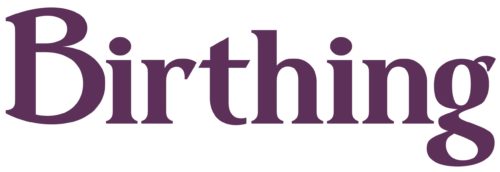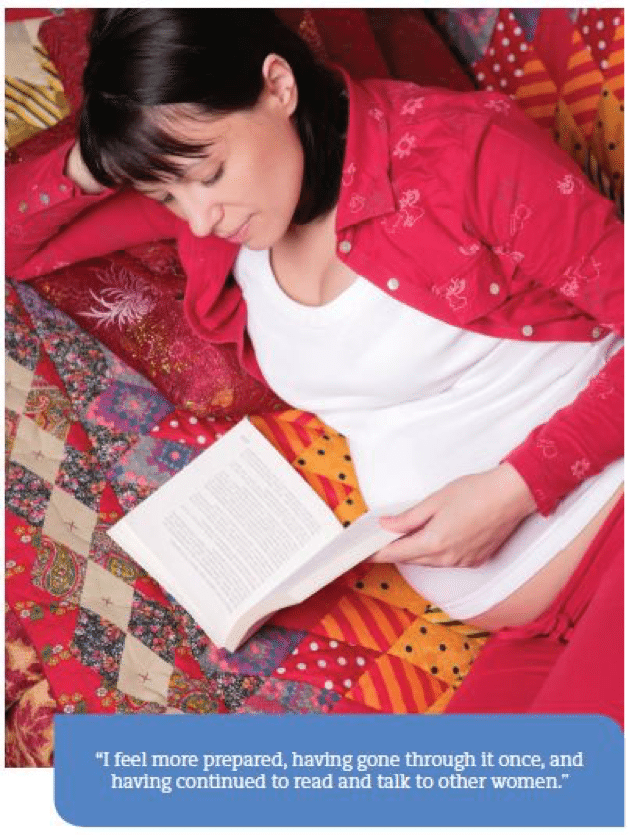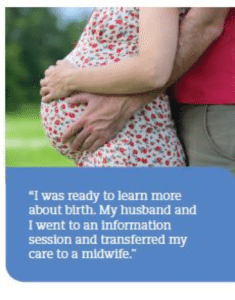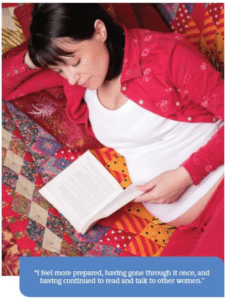The more I read birth stories and talk to other women about their birth experiences, the more I feel I was lucky to have the experience I did. I’ve realized that, as women, we need to educate ourselves about birth. I wouldn’t have done that if some friends hadn’t pointed me in the right direction.
When my husband and I first realized I was pregnant, we agreed that I should see a doctor before we shared that news. I called my general practitioner to book an appointment, but the nurse made me feel like I didn’t need to. My appointment was little better. The doctor simply repeated the pregnancy test and said, “You’re pregnant.” (I already knew that.) He then got out his chart to figure out my due date. I gave him the date of my last menstrual cycle, and asked if wanted to know when the baby was conceived. He laughed at me. I was miffed. Many women have irregular cycles. I knew exactly when I was fertile and when my husband and I had come together. That would have been more accurate information for predicting my due date than just my last menstrual cycle.
However, because this was my first pregnancy, I continued to see him keeping my questions and uneasiness to myself. My visits were ten minutes at most: a quick check of my blood pressure, weight and urine, and then he was gone. In one appointment, he handed me some forms and told me to go to a lab to get the tests done. As I sat in the lab, reading the label on the orange bottle I was drinking, I figured out that this was a glucose test. I wondered why the doctor hadn’t bothered to explain it to me. When I talked to other women, and learned that I had taken the test about ten weeks before it is usually given, I was even more confused.
A few weeks later, we visited my best friend’s parents. Their three oldest daughters (who have five sons between them) were also there, and my husband waited until all the women were in the room to announce our news. After the congratulations, one of the daughters asked if I’d heard of the local midwifery program. She had given birth to both her sons there, and thoroughly recommended a water birth, boasting of forty-minute labours.
By this time, I was ready to learn more about birth. My husband and I went to an information session and transferred my care to a midwife. The midwife talked to us for half an hour about what we wanted from this birth. She explained the tests the doctor wanted me to take, and discussed our concerns about those tests. We also asked her about ultrasounds. Quite a few years before, I had read something suggesting that ultrasounds weren’t completely safe, but I hadn’t felt comfortable raising that topic with my doctor. I tried asking my friends who’d had babies, but they didn’t know very much. The midwife gave us some more information and agreed with our decision not to have a routine ultrasound.
I then began the group appointments with the midwives. I liked being able to weigh myself, measure my own blood pressure, do my own urine test, and see the changes on the chart. I felt more in control and informed about what was going on with my body and my baby. I also liked being able to learn from the other mothers in the group, some of whom were having their second or third babies. The midwives shared their vast wealth of experience with us. I felt like I was learning significantly more than I had before. I also felt comfortable asking questions and raising my concerns.
When I was about five months pregnant, we visited friends of ours who had their baby just after our wedding. Their desire for a natural birth took them to a birthing centre in the States, because the midwives in Ontario wouldn’t provide the care they wanted. Their commitment to having a natural birth carried them through forty hours of labour at the birthing centre, with no interventions and no drugs. This friend introduced me to Henci Goer’s book The Thinking Woman’s Guide to a Better Birth and Robert Bradley’s book Husband-Coached Childbirth: The Bradley Method of Natural Childbirth.
I was hooked on learning more. I read all the books I could get my hands on, searched websites, and attended a prenatal course. My husband supported me, listening while I talked about what I was learning, reading the Bradley book and attending the course with me. At the same time, I felt that as much as I knew, birth was still a mystery. Every woman has a different experience. Of my two friends who had had natural childbirths, one had a forty-minute labour and the other had a forty-hour labour. I didn’t want either—one was too fast and the other was too slow!
In the end, my labour lasted ten hours; it started with hard contractions seven minutes apart at 5:40 am, and ended with my daughter’s birth in the hospital at 3:40 pm. For most of that time, only my husband was with me, except when the nurse popped in to check on me. I laboured in the shower or in the tub, and barely used any of the pain-coping techniques that we’d practiced. When transition hit, I felt like I couldn’t do it anymore, but I also knew that the baby was almost coming. Then I was in labourland, doing what my body told me to do. And when I held Sunshine, it was all worth it.
Looking back now, I see things that I will do differently with my next baby. I feel more prepared, having gone through it once, and having continued to read and talk to other women. As I hear stories of traumatic hospital experiences I am glad I didn’t blindly trust my doctor—I am grateful to the women in my life who helped me learn more and educate myself so that I could have the birth that I wanted.
Bonnie is a freelance writer and editor whose work has been published in a variety of publications. She is the editor of FellowScript, a quarterly writer’s newsletter. When she’s not writing, she’s busy as a mom and wife.




